MARIANI’SVirtual Gourmet
October 2, 2011
NEWSLETTER
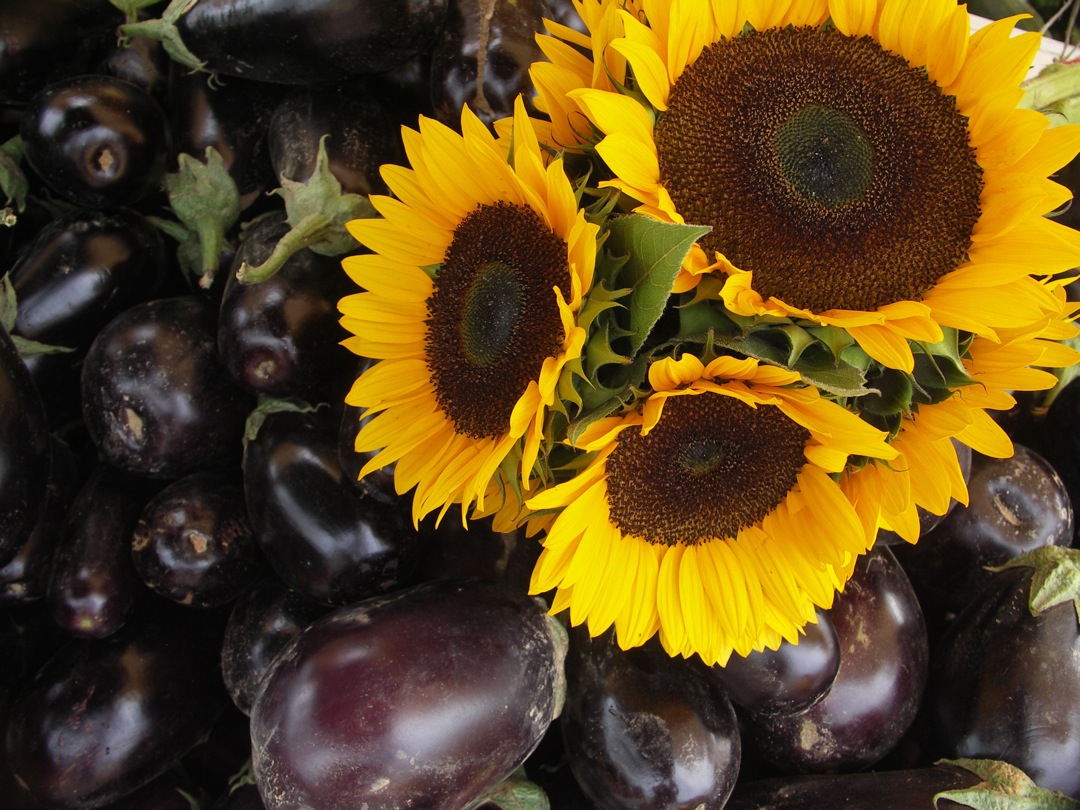
"Autumn Sunflowers and Eggplant, East Hampton, NY," by Galina Stepanoff-Dargery (2010)
VERY IMPORTANT ANNOUNCEMENT!
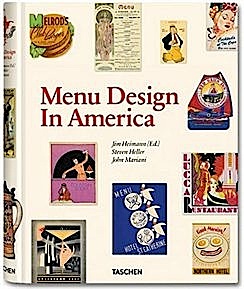 |
My latest book, written with Jim Heimann and Steven Heller, Menu Design in America, 1850-1985 (Taschen Books), has just appeared, with nearly 1,000 beautiful, historic, hilarious, sometimes shocking menus dating back to before the Civil War and going through the Gilded Age, the Jazz Age, the Depression, the nightclub era of the 1930s and 1940s, the Space Age era, and the age when menus were a form of advertising in innovative explosions of color and modern design. The book is a chronicle of changing tastes and mores and says as much about America as about its food and drink.
“Luxuriating vicariously in the pleasures of this book. . . you can’t help but become hungry. . .for the food of course, but also for something more: the bygone days of our country’s splendidly rich and complex past. Epicureans of both good food and artful design will do well to make it their cofee table’s main course.”—Chip Kidd, Wall Street Journal.
“[The menus] reflect the amazing craftsmanship that many restaurants applied to their bills of fare, and suggest that today’s restaurateurs could learn a lot from their predecessors.”—Rebecca Marx, The Village Voice.
“Restaurateurs, take note: A resurgence in thoughtful, artistic menus is past due.”—Bon Appetit Magazine |
THIS WEEK
STAYING PUT IN SANTA BARBARA
by Misha Mariani
NEW YORK CORNER: ARMANI/RISTORANTE FIFTH AVENUE
by John Mariani
MAN ABOUT TOWN: THE MOST BEAUTIFUL MEAL I'VE EVER SEEN
by Christopher Mariani
By Misha Mariani
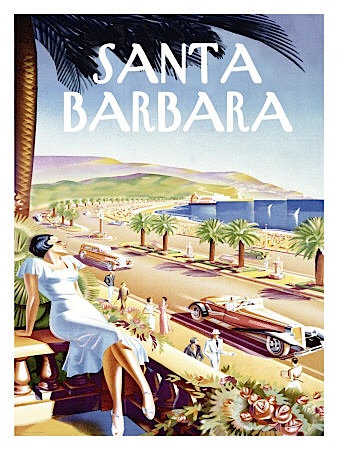 Too
often, Americans believe that travel should be
beyond their own borders, to go to Europe to see
architecture and experience cultures that date back
centuries, or to tropical paradises like French
Polynesian or Thailand to absorb the
exotic. I’ve grown up my entire
life in New York and will be the first to
admit how much I take one of the greatest cities of
the world for granted, wearing blinders that block
my visiting the vast number of shows, museums, and
landmarks the city has to offer. And this applies to
so many other cities and regions to visit right here
in the USA. How many people have seen the
glorious mountains of Montana, the magnificent
coastline of California that spans 840 miles of blue
Pacific waters, or the beauty of the
Northwest? At some point we all have to
realize the bounty of what we have right in front of
us, and one of those places Santa Barbara and its
huge wine region,
Too
often, Americans believe that travel should be
beyond their own borders, to go to Europe to see
architecture and experience cultures that date back
centuries, or to tropical paradises like French
Polynesian or Thailand to absorb the
exotic. I’ve grown up my entire
life in New York and will be the first to
admit how much I take one of the greatest cities of
the world for granted, wearing blinders that block
my visiting the vast number of shows, museums, and
landmarks the city has to offer. And this applies to
so many other cities and regions to visit right here
in the USA. How many people have seen the
glorious mountains of Montana, the magnificent
coastline of California that spans 840 miles of blue
Pacific waters, or the beauty of the
Northwest? At some point we all have to
realize the bounty of what we have right in front of
us, and one of those places Santa Barbara and its
huge wine region, all within
easy reach of the city.
Santa Barbara’s roughly 42 square
miles are filled with activities, beauty, warmth,
hospitality, and plenty of sunshine to bask in, a
city surrounded by low-lying Santa Ynez mountain
ranges and warm white sand beaches. You’ll notice
while walking down State Street that Santa Barbara’s
architectural motifs, strongly influenced by Latin
American and Spanish design, with its red terra
cotta rooftops and Mission styles, and don’t miss
the Santa Barbara Mission--“Queen of the Missions” (right)--with
its twin bell towers. Downtown is only a mere
30-45 minutes away from the Santa Ynez Valley, so
even a day trip up to the valley is feasible, but I
would definitely recommend an overnight stay to
enjoy it all. Downtown SB is also home to the Santa
Barbara Farmer’s Market , founded in 1983,
where all along a five-block stretch 130
local producers and
farmers gather together to showcase some of the most
spectacular fruits and vegetables grown in the
country . The market is set up in downtown SB
on State street on Tuesdays and Saturdays, else
where in the near by areas the rest of the week.
When seeking local lodging, look
no farther than the Cheshire
Cat Inn (below),
located on W. Valerio St. just off of State
Street, the main road that runs through the
heart of SB. The Cheshire Cat Inn is an adorable,
quaint inn comprised of two Victorian houses that
sit side by side to each other and are decorated in
a fanciful “Alice in Wonderland” motif, with
original vintage sketching, paintings and drawings
of scenes from one of our most memorable childhood
stories. 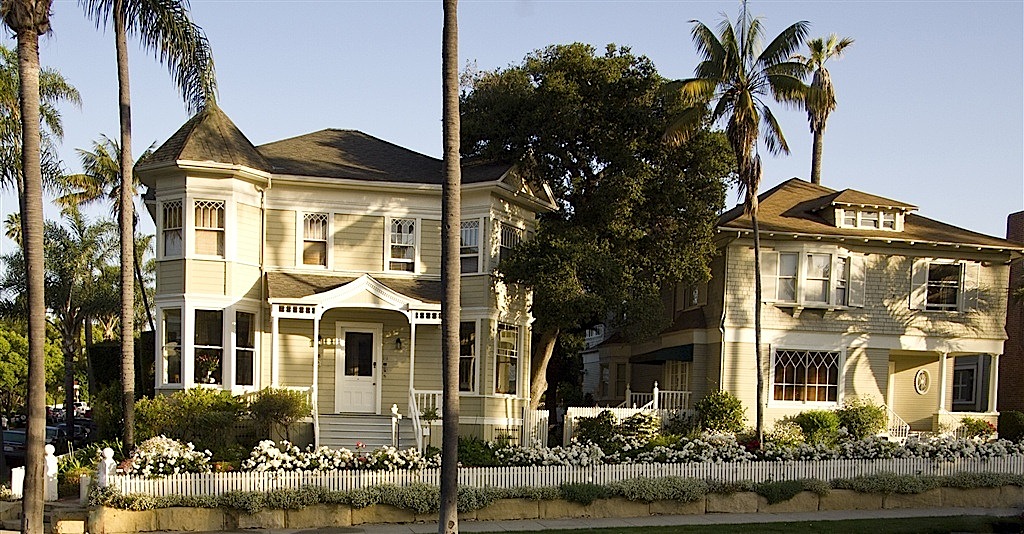
The room we happened to stay in
on our trip was called “Alice’s Balcony room” (below), dressed
in lovely designed ivory wallpaper, a two-cushion
love seat, and a split-level step up that housed a
plush Queen-sized bed just steps away from a balcony
overlooking a backyard of greenery, flowers, a
gazebo in which to enjoy late afternoon hors oeuvres
and wine put out every night at five o'clock. The
inn’s gazebo- covered hot tub is open to guests all
day/night long. And don’t rush off without enjoying
the complementary continental breakfast in the
morning, either at the communal dining room table
with some of the other guests or in a private old
wooden bench table nestled up against a bay window
looking out over the well-manicured frontyard, or
outside in the terrace with fresh California air and
sun. And keep your fingers crossed that during your
stay one of the breakfast made fresh every day are
the dangerously addictive Danish pancakes called
“Ebelskivers,” made in a special cast iron pan and
formed into balls filled with cream cheese and
dressed with warm raspberry jam.
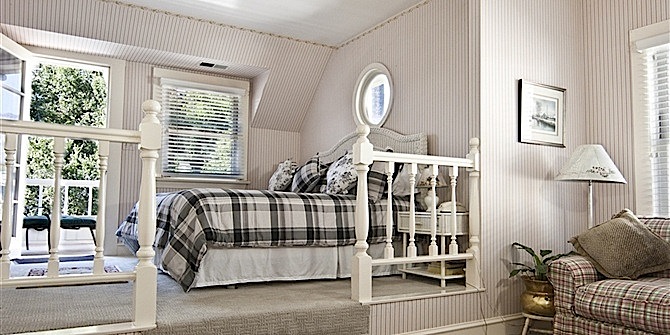 But this only
one of so many places in town to get great food.
Located down on 813 Anacapa St., you'll find Doug
Margerum’s Wine Cask
Restaurant
and tasting room (below); that’s right, he makes
wine too. Doug’s family opened Wine Cask in 1981,
became one of the most respected dining destinations
in Santa Barbara, and then in 2007 decided to sell
it in order to focus his efforts on making
wine, then bought it back just a few years
later. I’m happy about that because from what I
understand, the short-term owners didn’t do it any
justice, and Doug’s re-acquisition has brought it
back to its strong roots, with a more renewed and
revived feel. To help him do that is Co-Owner
Mitchell Sjerven and Executive Chef Brandon Hughes.
But this only
one of so many places in town to get great food.
Located down on 813 Anacapa St., you'll find Doug
Margerum’s Wine Cask
Restaurant
and tasting room (below); that’s right, he makes
wine too. Doug’s family opened Wine Cask in 1981,
became one of the most respected dining destinations
in Santa Barbara, and then in 2007 decided to sell
it in order to focus his efforts on making
wine, then bought it back just a few years
later. I’m happy about that because from what I
understand, the short-term owners didn’t do it any
justice, and Doug’s re-acquisition has brought it
back to its strong roots, with a more renewed and
revived feel. To help him do that is Co-Owner
Mitchell Sjerven and Executive Chef Brandon Hughes.
My girlfriend and I sat down to a
starter of "confit" of artichoke heart, a dish with
great potential but unfortunately poorly executed,
the artichokes not being trimmed properly, with
fibrous leaves that were inedible, and a tasty local
beet and baby carrot salad with fresh
chèvre, market herbs and tarragon
vinaigrette. Our entrees were hands-down
delicious and perfectly put together. A pan-seared
Kurobuta pork chop, a Berkshire pig raised in
Kagoshima Prefecture, with fava beans, wild mustard,
and cornbread panzanella
was one of the most tender and flavorful
pieces of pork I’ve had in quite some time and gave
me a feeling of relief because of the amount of U.S.
pork that is so fatless and flavorless. The mustard
with its bright acidity and the nutty cornbread with
its touch of sweetness harmonized the whole dish.
Also stellar was the grilled marinated rack of lamb
with lentils, cherry tomatoes, wilted dandelion
greens and spiced Muscat-reduction, another dish of
complementary flavors, the sweetness and acidity of
the market cherry tomatoes matched with the
bitterness of the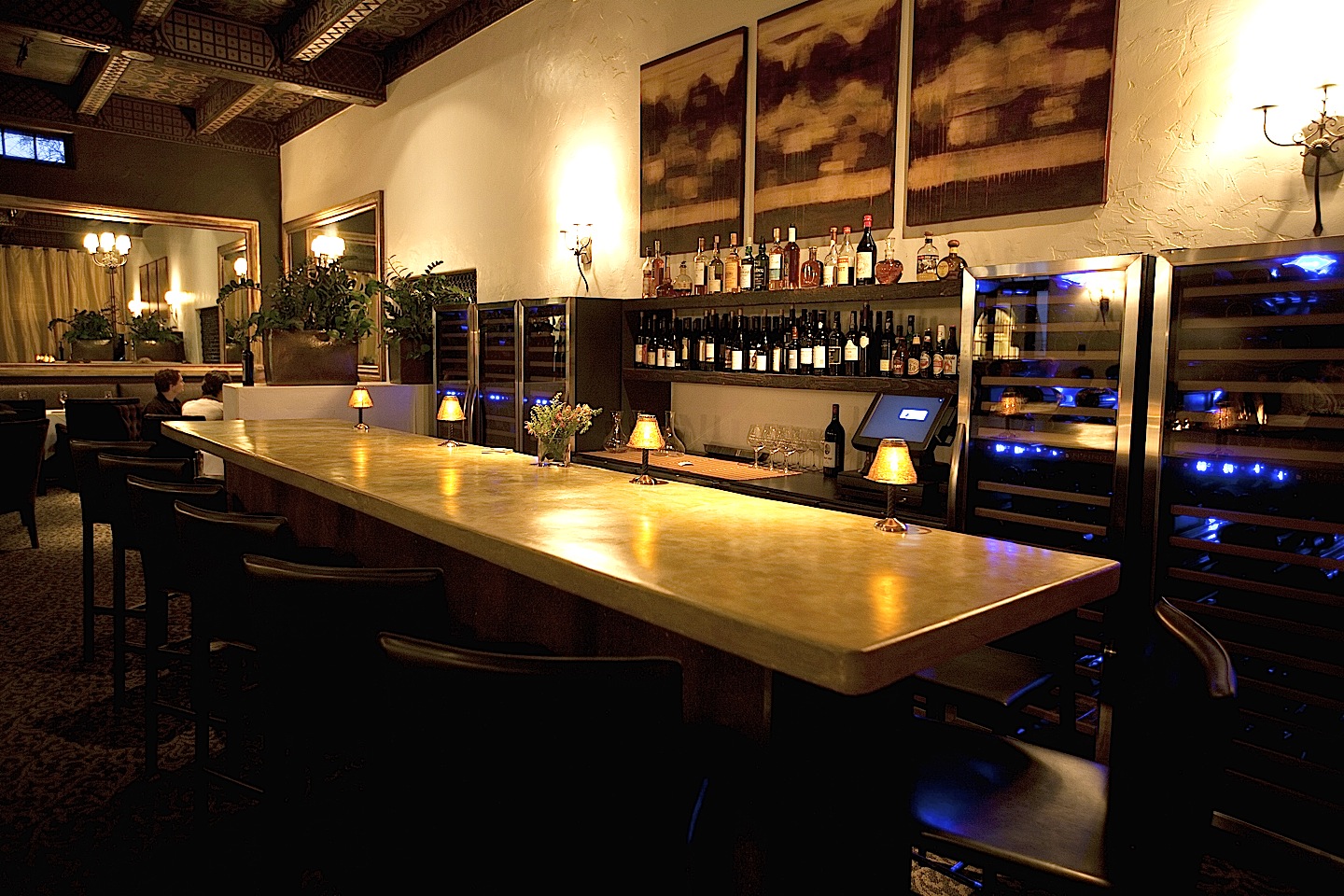 dandelion
greens and the fattiness of the domestic lamb.
dandelion
greens and the fattiness of the domestic lamb.
Wine Cask is also one of only two
restaurants (The Four Seasons, below, being the
other) that has its own in-house pastry chef, Rosie
Gerard, who has had stints with Daniel Boulud and
other great pastry chefs. Don’t leave without having
her butterscotch pudding and the chocolate and
chèvre doughnuts--decadent!
As I mentioned, Doug is also the
wine maker for Margerum, so make it a point to stop
by their tasting room to try some of their wines,
also a part of the Urban Wine
Trail. I recommend the 2010 V.D.P.
Rosé made from 100% Grenache grapes that have
been imported from Vaucluse, with an aromatic and
fruitful nose but showing slightly dryer on the
palate than you’d expect from what you get on the
nose; the 2008 Piocho Happy Canyon Vineyard with its
rich, heavier, higher alcohol palate, with red bell
pepper on the nose and a great granite minerality;
and lastly his 2010 Riesling, a varietal I adore,
crisp, bright and well-balanced acidity, great
minerality, apples on the nose and low-residual
sugar, similar to a German Kabinett.
Not far from downtown,
is The
Four Seasons The
Biltmore, the hotel
that the Kardashian/Humphries guests and entourage
stayed at during their wedding weekend. The Biltmore is definitely the
place you want to stay if planning on splurging or
just simply want to enjoy your vacation in the lap
of luxury, with on premise spa, outdoor pool,
exceptional dining and warm hospitality. Unfortunately we didn’t stay here, but
we did have the opportunity to dine at Bella Vista,
one of their three restaurants, for lunch. The room
is an airy dining room opening out onto a veranda (below) that
overlooks the Pacific Ocean, walls a soft burnt
orange clay, warm weather foliage, and hammocked
drapes hanging above as the only barrier between you
and the open sky. We even had a pleasant surprise
guest while dining, a small sparrow navigating its
way around the dining room before slipping back out
of the ceiling.
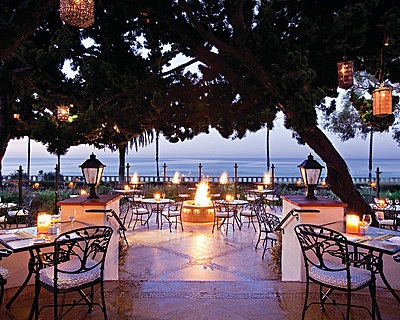 We started
with creamy burrata
mozzarella and heirloom tomatoes with chive
blossoms, and a tomato gazpacho with crab that was
well seasoned and balanced with acidity. A little
extra fat or olive oil wouldn’t have hurt. Next was
pan-seared bass with a summer vegetable hash and
sautéed spinach, as well as pan-seared
scallops with an English pea and lemon risotto, not
a ground-breaking dish but well prepared and
delicious.
We started
with creamy burrata
mozzarella and heirloom tomatoes with chive
blossoms, and a tomato gazpacho with crab that was
well seasoned and balanced with acidity. A little
extra fat or olive oil wouldn’t have hurt. Next was
pan-seared bass with a summer vegetable hash and
sautéed spinach, as well as pan-seared
scallops with an English pea and lemon risotto, not
a ground-breaking dish but well prepared and
delicious.
A huge component of Santa
Barbara’s heartbeat is its booming and vital wine
culture, paired with the unique geographical design
of its transverse mountain ranges in the Santa Ynez
Valley that creates a climate much different from
the rest of California’s blistering hot regions.
What makes this range unique is that it
spreads all the way west to the Pacific, where the
coastal breezes are funneled inland and help keep
the vineyards cool, creating pockets of
micro-climates that can mimic the cool nights of
Burgundy and extend the growing season, allowing for
greater and more gradually matured grape clusters,
and creating wines that have greater fruit
development and still that pop of acidity that a lot
of big Cali wines lack due to their rapid
maturation.
One way to experience what Santa
Barbara wine country has to offer is through its
Urban Wine Trail, developed by a group of
local wineries that have set up their tasting rooms
all within close proximity of each other in order to
offer wine lovers the chance to taste what’s
happening in the wine world of the Santa Barbara
region, most for the inexpensive price tag of about
$10 per person. You might glimpse some of them in
the hit film "Sideways."
Part of this Urban Wine Trail is
wine maker and owner Seth Kunin (right) of Kunin
Wines,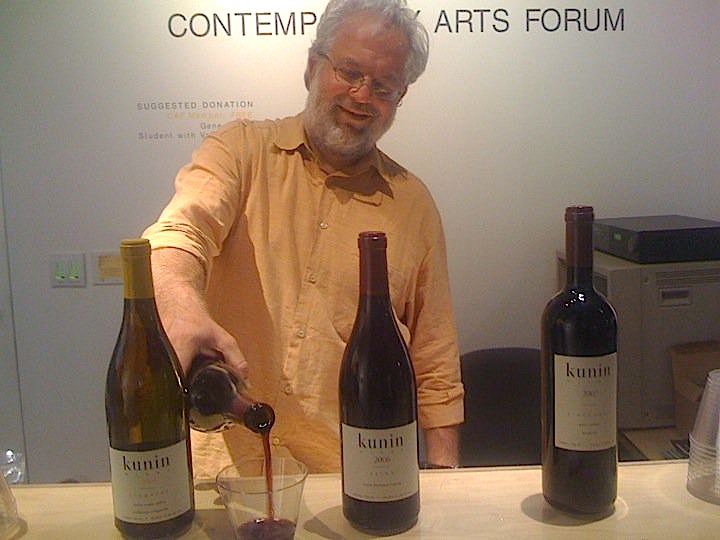 who has an
affinity and admiration for Rhône-style wines
and can be found most days in his tasting room
pouring and running through his wines for visitors
just stopping by for a casual wine tasting. And
don’t be surprised if he pulls out maps and info to
help you further understand where his philosophy and
wines come from. Kunin founded his winery in
1998 after a long career in the NYC restaurant
business, eventually moving to California, working
the vineyards and developing his passion and
expertise for wine making. His philosophy is that of
many Old World wine makers, where wine should be the
expression of the grapes and terroir and not the
medium for manipulation through the use of too much
oak. Seth produces Syrahs, Zinfandels, Viogniers,
and blends that show depth, complexity, restraint,
and balance that simply excite the palate. Wines to
try: Sauvignon Blanc ‘Grassini Vineyard’ 2010 and ‘Pape Star’
Rhone Blend 2009 (PHOTO 5), with ripe blue and dark
fruits on the nose and palate, an earthiness of
slate and clay minerality, and hints of smoke and
spice, a truly enjoyable blend. Other don’t-misses
along the trail are Margerum
Wine Company, Municipal
Winemakers, and Whitcraft
Winery.
who has an
affinity and admiration for Rhône-style wines
and can be found most days in his tasting room
pouring and running through his wines for visitors
just stopping by for a casual wine tasting. And
don’t be surprised if he pulls out maps and info to
help you further understand where his philosophy and
wines come from. Kunin founded his winery in
1998 after a long career in the NYC restaurant
business, eventually moving to California, working
the vineyards and developing his passion and
expertise for wine making. His philosophy is that of
many Old World wine makers, where wine should be the
expression of the grapes and terroir and not the
medium for manipulation through the use of too much
oak. Seth produces Syrahs, Zinfandels, Viogniers,
and blends that show depth, complexity, restraint,
and balance that simply excite the palate. Wines to
try: Sauvignon Blanc ‘Grassini Vineyard’ 2010 and ‘Pape Star’
Rhone Blend 2009 (PHOTO 5), with ripe blue and dark
fruits on the nose and palate, an earthiness of
slate and clay minerality, and hints of smoke and
spice, a truly enjoyable blend. Other don’t-misses
along the trail are Margerum
Wine Company, Municipal
Winemakers, and Whitcraft
Winery.
After four fantastic days in
downtown Santa Barbara, it was time to make our way
through the curvy roads of the mountains up to wine
country for the day, where we drove up to Ballard, a
town of just a thousand residents--visit the 1882
schoolhouse here--and pulled into the Ballard Inn
(below), a
Victorian bed & breakfast that, when we
mentioned we were staying there, made everyone
respond eyes wide open, “Oh!, 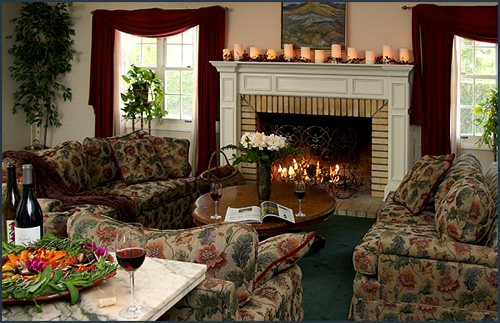 You’re going to love it,”
and they were right. The Ballard Inn is a charming
B&B, opened in 1985 and now owned by the Kazali
family, who purchased it in 2004 and made it into
one of the most desirable and lovely places to stay
on a trip up the Santa Ynez Valley. The Inn is
designed in a very classic manner, with antique
furnishing, hardwood floors and area rugs, wine
paraphernalia, and assorted design motifs, yet all
staying within harmonious boundaries. We
happened to stay in The Equestrian Room (below) on this
trip, with dark green rugs, beige walls, adorable
candle sconces, plush leather chairs with copper
rivets set around a dark stained breakfast table,
and vintage photos/paintings of horses,
appropriate since Ballard was named after the
proprietor who owned one of the original Wells Fargo
stagecoach station in town.
You’re going to love it,”
and they were right. The Ballard Inn is a charming
B&B, opened in 1985 and now owned by the Kazali
family, who purchased it in 2004 and made it into
one of the most desirable and lovely places to stay
on a trip up the Santa Ynez Valley. The Inn is
designed in a very classic manner, with antique
furnishing, hardwood floors and area rugs, wine
paraphernalia, and assorted design motifs, yet all
staying within harmonious boundaries. We
happened to stay in The Equestrian Room (below) on this
trip, with dark green rugs, beige walls, adorable
candle sconces, plush leather chairs with copper
rivets set around a dark stained breakfast table,
and vintage photos/paintings of horses,
appropriate since Ballard was named after the
proprietor who owned one of the original Wells Fargo
stagecoach station in town.
After we settled in, it
was time to visit a few wineries and the Lampoc Wine
Ghetto in the valley. Our first stop was Buttonwood
Winery, 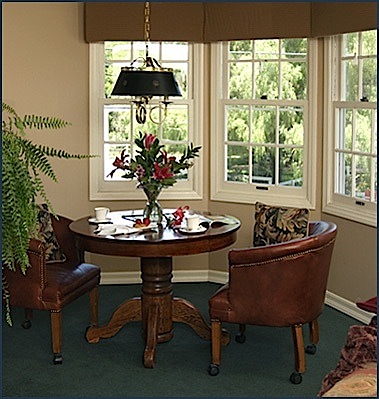 a winery focusing on
sauvignon blanc, semillon, marsanne, merlot,
cabernet sauvignon, cabernet franc, and syrah, not
unlike many other wineries of this region, but
Buttonwood has really distinguished themselves from
the rest in my opinion. Set on a 39-acre
vineyard amidst 109 total acres, the winery is owned
by Betty Williams and her son-in-law Bret Davenport,
who have chosen to emulate the styles and techniques
of Bordeaux and the Rhône. Their wines, unlike
so many in California, see minimal oak, are truly
balanced, and aren’t the gigantic fruit bombs that I
can never get used to. Buttonwood's wines are
elegant, refined, structured, and reflective
of their varietals. They produce many single
varietal wines as well as a few blends, and to top
it off, they are all very modestly priced. Wines to
try; 2010 Buttonwood Sauvignon Blanc “Zingy” $18 and
the 2008 Buttonwood Cabernet Franc $22. Buttonwood,
along with their wines, also has acres of peach
trees, which they are know for so make sure to pick
up a dozen or so, one of the best peaches I have
ever had.
a winery focusing on
sauvignon blanc, semillon, marsanne, merlot,
cabernet sauvignon, cabernet franc, and syrah, not
unlike many other wineries of this region, but
Buttonwood has really distinguished themselves from
the rest in my opinion. Set on a 39-acre
vineyard amidst 109 total acres, the winery is owned
by Betty Williams and her son-in-law Bret Davenport,
who have chosen to emulate the styles and techniques
of Bordeaux and the Rhône. Their wines, unlike
so many in California, see minimal oak, are truly
balanced, and aren’t the gigantic fruit bombs that I
can never get used to. Buttonwood's wines are
elegant, refined, structured, and reflective
of their varietals. They produce many single
varietal wines as well as a few blends, and to top
it off, they are all very modestly priced. Wines to
try; 2010 Buttonwood Sauvignon Blanc “Zingy” $18 and
the 2008 Buttonwood Cabernet Franc $22. Buttonwood,
along with their wines, also has acres of peach
trees, which they are know for so make sure to pick
up a dozen or so, one of the best peaches I have
ever had.
Now it was onward to the Lompoc Wine
Ghetto, an industrial area in the Lompoc
Valley, where about a dozen winemakers of the region
have grounded themselves with their production
facilities or tasting rooms, and offers a broad view
of what some of the more regarded winemakers are
produces from the fruits of this great area. The
Lompoc Ghetto was created to offer an affordable
route for small entrepreneurs starting up their own
wine labels and providing shared wine making
facilities that neighboring cellars could
facilitate, helping to cut costs.
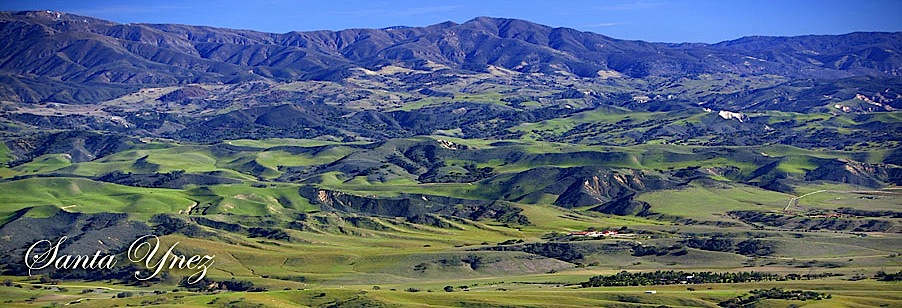 If you can’t find the
time to work your way through all the tasting rooms
in the ghetto, be sure to make your way through the
doors of Fiddlehead
Cellars and
Flying
Goat Cellars,
whose focus is predominantly pinot noir, and
Palmina,
owned and founded by Steve Clifton, who has taken
inspiration from Italy’s wine making heritage and
has created a line up of some Italy’s great
varietals, specifically those found in Piemonte such
as barbera, dolcetto, nebbiolo, and arneis, along
with other regional greats like friulano, pinot
grigio and malvasia. Steve isn’t trying to recreate
Italy’s great wines but rather take inspiration and
apply that to Santa Barbara’s similarly cool wine
growing region.
If you can’t find the
time to work your way through all the tasting rooms
in the ghetto, be sure to make your way through the
doors of Fiddlehead
Cellars and
Flying
Goat Cellars,
whose focus is predominantly pinot noir, and
Palmina,
owned and founded by Steve Clifton, who has taken
inspiration from Italy’s wine making heritage and
has created a line up of some Italy’s great
varietals, specifically those found in Piemonte such
as barbera, dolcetto, nebbiolo, and arneis, along
with other regional greats like friulano, pinot
grigio and malvasia. Steve isn’t trying to recreate
Italy’s great wines but rather take inspiration and
apply that to Santa Barbara’s similarly cool wine
growing region.
So, after a long day of tasting,
it was back to the Ballard Inn, where we took a
quick nap and got ready for dinner, just a flight of
stairs away. Chef Budi Kazali, proprietor and chef,
has spent years honing his skills under some big
name chefs like Ming Tsai of Blue Ginger in
Wellesley, MA, and San Francisco's Gary Danko and
now runs his own restaurant
within the Ballard Inn. Located on the first floor,
the 12-table dining room is a Victorian-design
room with white tablecloths, a fireplace with a
wooden mantel and 16-pane windows looking out onto a
front porch where we dined. We sat outside watching
the sun set while sipping a glass of Champagne and
were greeted by our welcoming server, who is just
one among a staff here that truly exudes a feeling
of warmth, hospitality, generosity, and knowledge.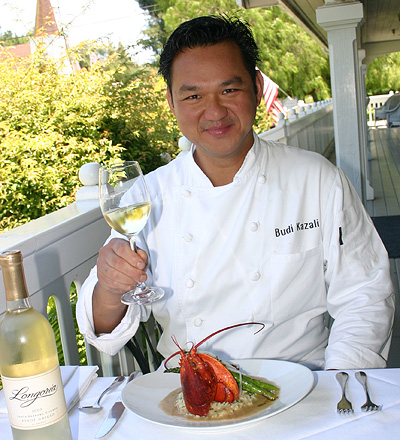
Our first course was a sashimi of
hamachi with avocado, yuzu, daikon sprouts and fried
ginger. A simple dish you can find in many Asian
fusion restaurants, but Chef Kazali (right) really
shows that it takes an experienced hand to make the
simplest dish sing, and sing it did. Perfectly
balanced flavors with the richness of the hamachi
and avocado being cut by the tart citrusy yuzu and
pepped up by the ginger. This was followed by a
sweet white corn soup with crab toast and basil
oil--I could have put away a couple more
bowls, it was so good. Next was an uninspiring Kurobuta
pork belly with Asian pear and sautéed
cabbage, which was fairly bland and under seasoned.
But this seemed to have been just a hiccup, because
the New Zealand grouper with edemame rice,
house-made chorizo and cockle clams was a hit. The
grouper perfectly cooked and moist, the chorizo
spicing up the dish just enough, and the salinity
and sweetness of the cockles made for quite an
exciting dish. Along with our meal, we decided to do
the wine pairing--which I highly recommend, with
most of the selections coming from the local area
and served by staff that you can tell have been
raised in a lifetime of wine. We finished our last
sips of dessert wine and then slowly retreated back
to our room where we slipped away into our dreams
with smiles of satisfaction.
So whether you’re a foodie and wine lover or
just someone looking to lay back, get some sun and
lose yourself in relaxation, be sure to consider
Santa Barbara as a front runner for you vacation
destination.
Some Other Great
little spots to dine in downtown Santa Barbara:
D’Angelo’s Bakery, The Hungry Cat & Taqueria
Rincon Alteña.
❖❖❖
NEW YORK CORNER
by
John Mariani
ARMANI/Ristorante
Fifth Avenue
717 Fifth Avenue (at
56th Street)
212-207-1902
www.armani5thavenue.com
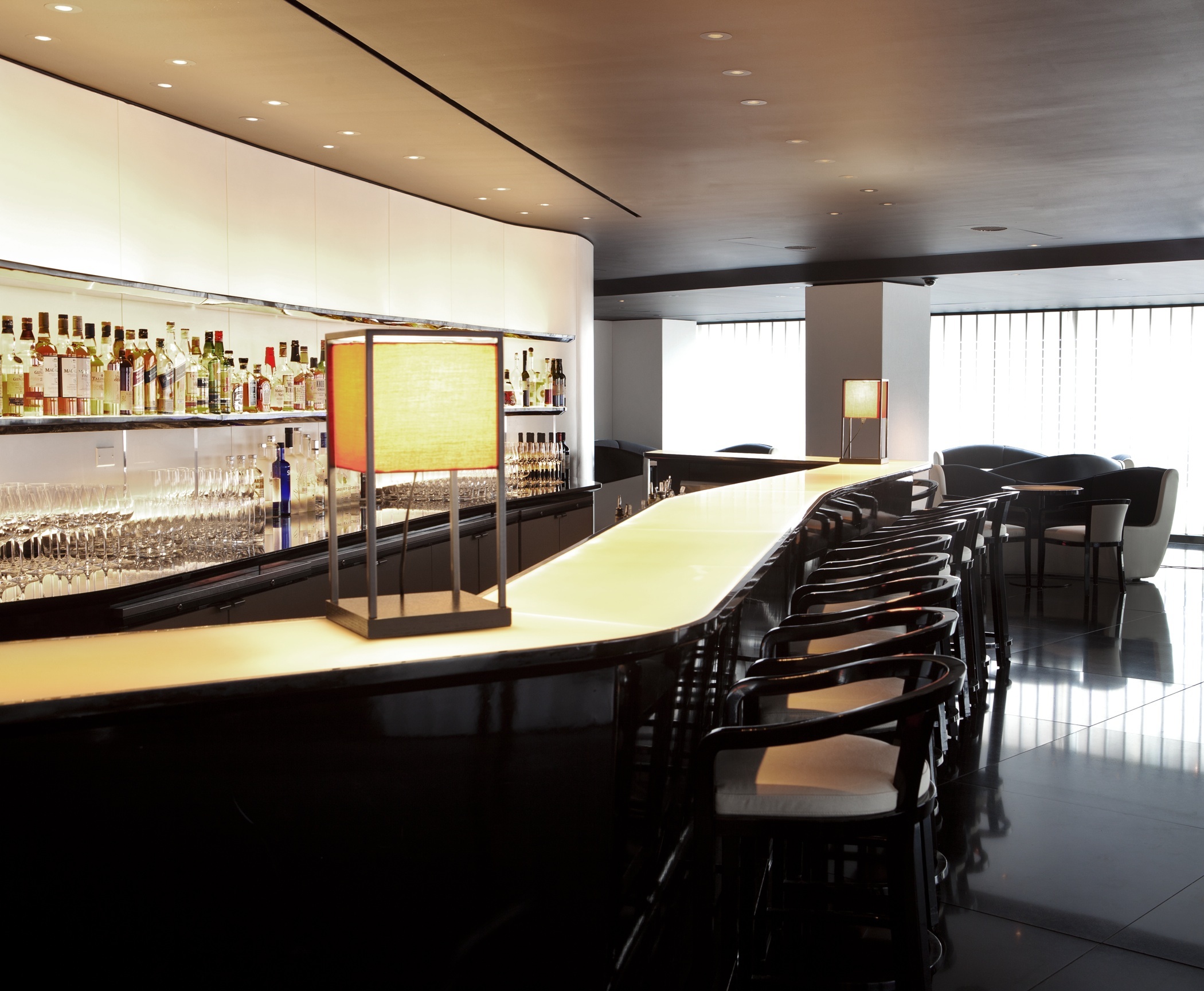 Once
upon a time NYC department stores' eateries were
ladies' lunch or tea rooms, and they lagged far behind
excellent modern restaurants in European stores, like
Harrod's, Marks & Spencer, and Harvey Nichols in
London, Galeries Lafayette in Paris, and KaDeWe in
Berlin. Since then attempts at putting
restaurants in NYC stores have given us Burke's
Cafe and Burke in a Box at Bloomingdale's and
Fred's in Barney's, but designer Giorgio Armani knew
he had to reflect his own northern Italian heritage
with a very fine ristorante
if it were going to have his name on it.
Once
upon a time NYC department stores' eateries were
ladies' lunch or tea rooms, and they lagged far behind
excellent modern restaurants in European stores, like
Harrod's, Marks & Spencer, and Harvey Nichols in
London, Galeries Lafayette in Paris, and KaDeWe in
Berlin. Since then attempts at putting
restaurants in NYC stores have given us Burke's
Cafe and Burke in a Box at Bloomingdale's and
Fred's in Barney's, but designer Giorgio Armani knew
he had to reflect his own northern Italian heritage
with a very fine ristorante
if it were going to have his name on it.
You enter, awkwardly, on a
less-than-stylish elevator, but when the doors part
you step into an exceedingly stylish split-level room
indeed, with three gorgeous hostesses wearing Armani
to greet you warmly. Seductive lighting emanates from
the bar (left)
and walls of glass with twinkling curtains bring in
the lights of Fifth Avenue. Walls and banquettes
and surfaces are curved, the floors and ceilings jet
black, all very civilized, without (overly) loud house
music.
Armani brought to NYC one of
his favorite chefs (the
second here since 2009),
Roberto Deiaco, who comes from the Italian
Dolomites, and he is keeping the menu
delightfully free of clichés, as evidenced by
an antipasto item of sautéed sea scallops on
"thousand-layer" potatoes with black summer truffles
(by now, perhaps, black autumn truffles), and a dish
of rock lobster croquettes that you'll just want to
pop in your mouth (though at $19, you'll probably
prolong the pleasure). There is also marinated goose
foie gras with black figs, and the classic vitello tonnato,
a beautiful, creamy rendering of this Piedmontese
favorite. 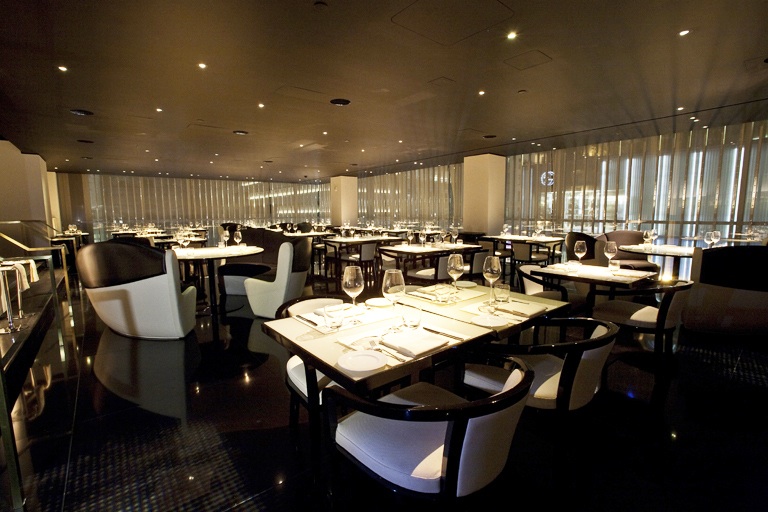
The pasta section is lavish with
offerings, from potato-and-caciotta cheese-stuffed ravioli with
leeks, branzino
and zucchini flower sauce to fresh whole wheat tagliarelle (one
of the first I've ever really enjoyed) with
chanterelles, crispy Speck bacon, and a parsley root
puree. Fat agnolotti
are packed with foie gras in a white butter and
truffle sauce--a great and simple dish. The very best
of all was a lasagnetta
croccante, which came as featherweight layers
of pasta with veal ragù served over a light
Parmigiano foam--exquisite, modern, but very Italian,
too. Deiaco also does risotto right, which on the
night I visited was rich with vegetables and shaved
Castelmagno cheese, all perfectly al dente.
I suspect a lot of Armani
shoppers stop there--and skinny models probably don't
get that far--but the main courses are sumptuously
rewarding. Oven-baked wild sea bass (what a
difference the wildness makes in flavor) comes over
new potatoes and asparagus tagliatelle, and roasted veal
tenderloin is set atop braised baby seasonal
mushrooms. A beautiful roasted Colorado lamb
chop comes with very tasty stuffed peperoncini with
roasted baby artichokes in a dark red reduction of
Chianti wine. And if you crave veal alla milanese,
lightly breaded and crisply fried, have it here with
baby arugula and fresh tomatoes on top.
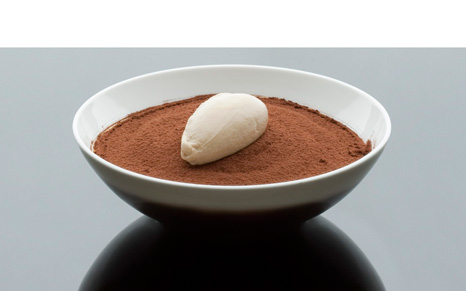
Some of these dishes are among
the "selezione
Armani," apparently the designer's favorites,
which include the simplest of pennette pasta
with tomato sauce. The fresh fruit crostata and
tiramisù (left)
are also on this short list.
Armani's wine selections are
very strong, with an admirable array of wines under
$50 here, all well chosen. Trust the
well-trained--and quite handsome--service staff to
guide you, foremost the improbably named but very
suave and very sharp Sean Scottini.
Now, you would
think, given the Armani label, this would all cost a
fortune, and while prices are high, they are no higher
than at places like Del Posto or Ai Fiori, and
considerably lower than top French restaurants, with a
$34 fixed price lunch, in addition to à la
carte.
For many this two-year-old
restaurant has been something of an afterthought
because it is
in a store, however posh, and it is on the second
floor. But once in that beautiful, softly
lighted, seductive space, you will hardly think of it
in any other way but as a very fine Italian restaurant
with a very fine, very chic polish.
Armani/Ristorante 5th Avenue is open for lunch and dinner daily, and brunch on weekends. Antipasti run $16-$24, pastas $24-$30, main courses $28-$48.

MAN ABOUT TOWN
by Christopher Mariani
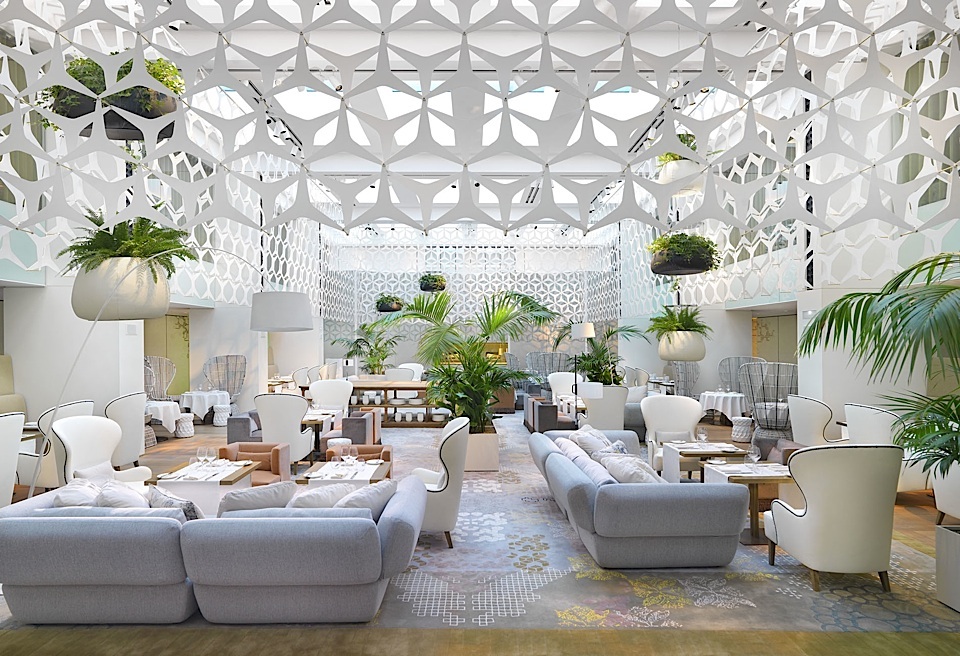
 most excellent upscale restaurant I dined
at in all three cities. Not only was this the finest
meal I had during my stay but also the most beautiful
meal I may have ever seen. The splendor of this meal had
nothing to do with fancy, over-the-top presentations,
instead it simply focused on the beauty of each
individual ingredient in its freshest and purest state.
most excellent upscale restaurant I dined
at in all three cities. Not only was this the finest
meal I had during my stay but also the most beautiful
meal I may have ever seen. The splendor of this meal had
nothing to do with fancy, over-the-top presentations,
instead it simply focused on the beauty of each
individual ingredient in its freshest and purest state.The interior of Blanc was designed by Patricia Urquiola and showcases her ever-creative and very unique style. Blanc fills the space of what was once a bank, actually sitting directly where the trading floor once existed. The entire space is now blanketed in pristine white, disrupted only by an occasional green plant or a subtle bouquet of flowers. Light shines through the glass ceiling, making this one of the most revitalizing dining rooms I’ve ever dined inside.
Chef Jean Luc runs the kitchen and is doing things in Barcelona that few others are even
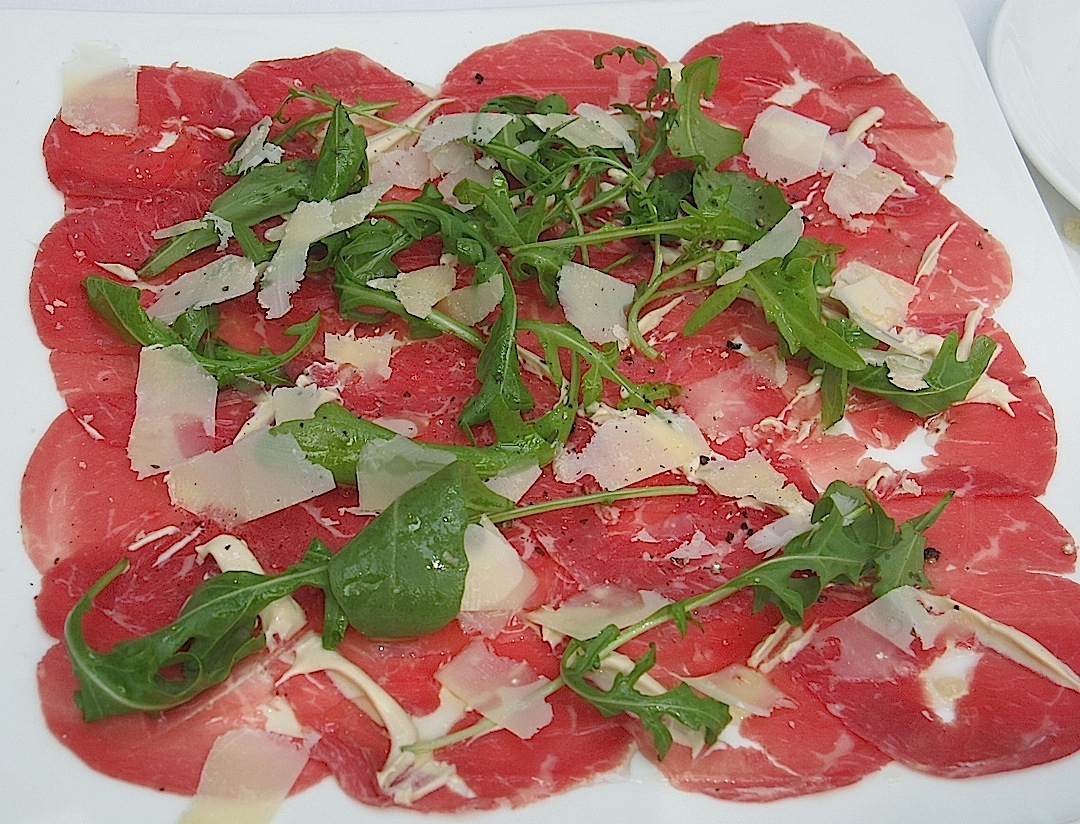 attempting,
without resorting to the trendy molecular style. I
started with an order of bright green peas served in a
delicate cod tripe broth. The sweetness of the peas was
like nothing I had ever tasted in the States and was
well balanced by the flavor of the salty cod. The peas
were just slightly cooked, leaving them nice and firm,
with a slight pop every time my teeth broke the outer
skin of each pea. Chef then placed beef carpaccio on a
white plate with shavings of parmesan cheese, fresh
arugula tossed in olive oil and topped the dish with
cracked black pepper. The intense colors of red and
green shot up from the plate as the sun beamed down from
above. I took some time to appreciate how gorgeous these
ingredients truly were before taking my first bite. This
dish should be a reference for all chefs who cluster
their plates and try too hard to impress the guest’s
eyes.
attempting,
without resorting to the trendy molecular style. I
started with an order of bright green peas served in a
delicate cod tripe broth. The sweetness of the peas was
like nothing I had ever tasted in the States and was
well balanced by the flavor of the salty cod. The peas
were just slightly cooked, leaving them nice and firm,
with a slight pop every time my teeth broke the outer
skin of each pea. Chef then placed beef carpaccio on a
white plate with shavings of parmesan cheese, fresh
arugula tossed in olive oil and topped the dish with
cracked black pepper. The intense colors of red and
green shot up from the plate as the sun beamed down from
above. I took some time to appreciate how gorgeous these
ingredients truly were before taking my first bite. This
dish should be a reference for all chefs who cluster
their plates and try too hard to impress the guest’s
eyes.Next, Jean Luc sent out a hot plate of wild mushrooms topped with seared duck foie gras. The foie gras was crisp, so that the top and bottom had a slight crunch, leaving the inside tender and rich, with the fat inside slightly melting. The play on textures throughout the entire meal was executed with perfection, leaving
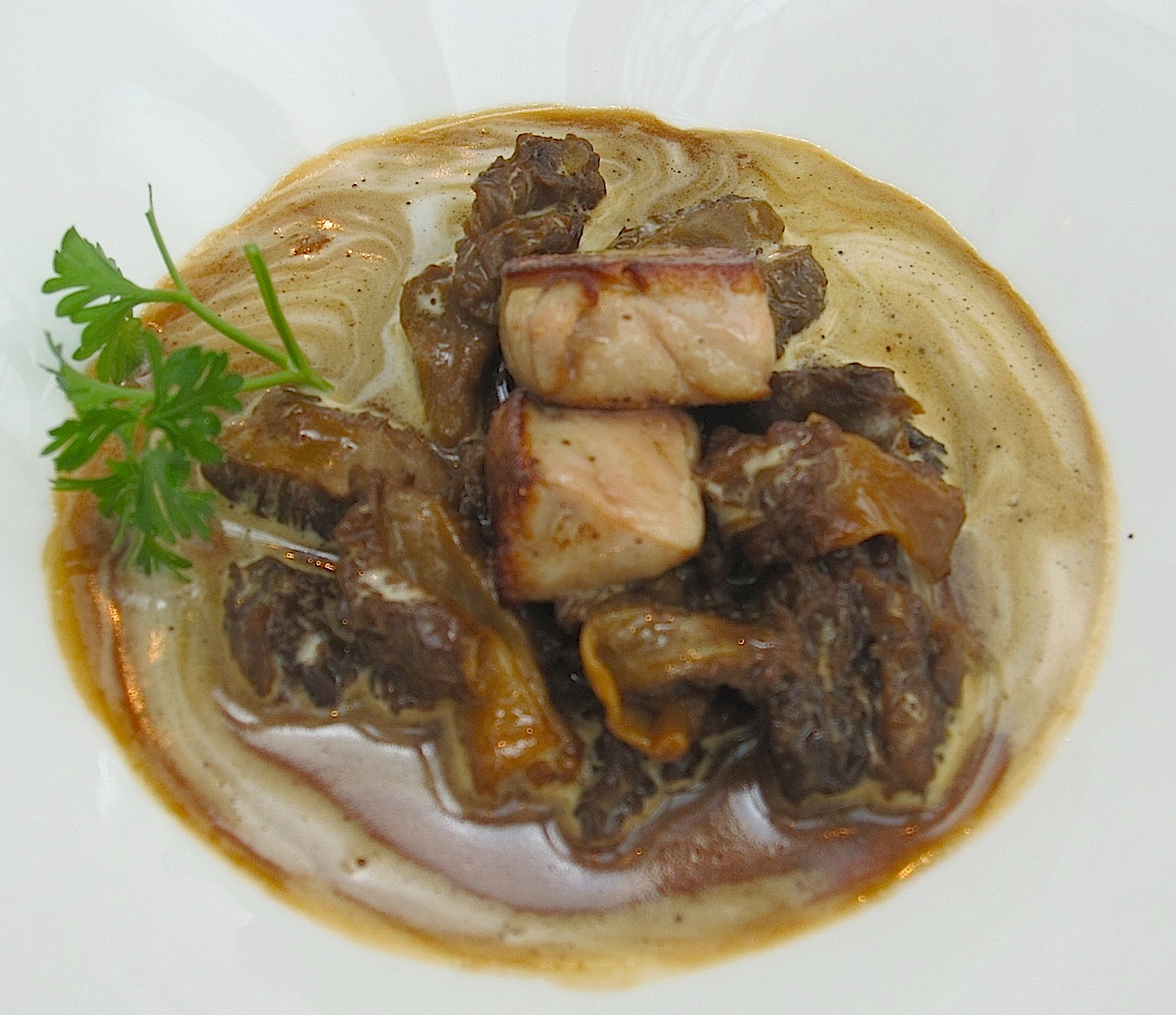 the palate constantly wanting more. I
finished off the lunch with a sirloin steak, cooked
rare, with a side of creamy, buttery mashed potatoes.
the palate constantly wanting more. I
finished off the lunch with a sirloin steak, cooked
rare, with a side of creamy, buttery mashed potatoes.Blanc also has an expansive wine list, offering over 600 labels from around the world. Notable wines served during our meal included were a Recaredo Can Credo, a white Penedés crianza made from the unusual Xarel-lo grape (commonly used to make a sparkling wine) and a glorious dessert wine--Selección Especial Moscatal 2005 by Jorge Ordonez from Malaga.
I give a lot of credit to Jean Luc for combining the three components that make for an exceptional meal -- presentation, flavor and texture. What many chefs fail to understand is that each of these three characteristics must compliment one another and work in harmony to enhance the dish. Chef Jean Luc’s dishes hit the table and immediately please the eye, not because they are fancy and complicated with dots of sauce and swirls all over the place, but because they are simply attractive. The aromas of Luc’s dishes then rise up to the nose, increasing one interest to taste the food. Finally, when the food enters your mouth, it delights the palate with both explosive flavors and textures. This is a talent that takes years to perfect and cannot be replicated through mere dazzle and flair. Save art for art's sake, not for the plate, where good taste should always be the guide.
BONG!
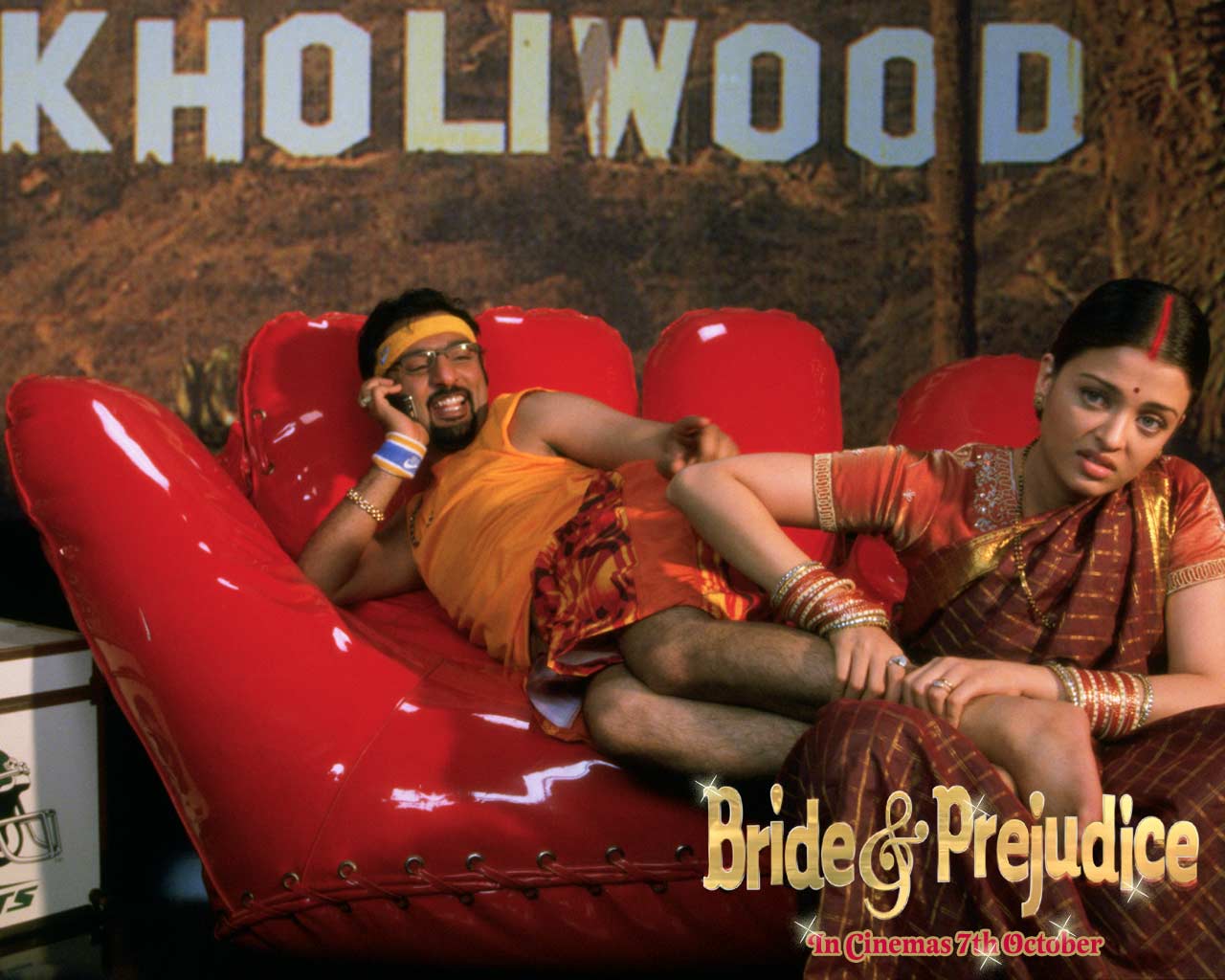
In Kent, England, restaurateur Dev
Biswal of the Ambrette was arrested for carrying a
plastic pillow of dried weed police suspected was
marijuana. Biswal
had a difficult and embarrassing time explaining it
actually contained a herb traditionally used as part
of a Hindi fertility menu.
 WORST SIMILE OF THE YEAR. . .
SO FAR
WORST SIMILE OF THE YEAR. . .
SO FAR
George
Metz, author of Hamburger
America, says he is a big fan of the green
chile burger at Bobcat Bite in Santa Fe, even though
it's made by a vegetarian cook, of whom Metz says, "I
liken him to Beethoven being deaf."
❖❖❖
Any of John Mariani's
books below may be ordered from amazon.com.
"Eating Italian will never be the same after reading John Mariani's entertaining and savory gastronomical history of the cuisine of Italy and how it won over appetites worldwide. . . . This book is such a tasteful narrative that it will literally make you hungry for Italian food and arouse your appetite for gastronomical history."--Don Oldenburg, USA Today. "Italian
restaurants--some good, some glitzy--far
outnumber their French rivals. Many of
these establishments are zestfully described
in How Italian Food Conquered the World, an
entertaining and fact-filled chronicle by
food-and-wine correspondent John F.
Mariani."--Aram Bakshian Jr., Wall Street
Journal.
"Equal parts
history, sociology, gastronomy, and just
plain fun, How Italian Food Conquered the
World tells the captivating and delicious
story of the (let's face it) everybody's
favorite cuisine with clarity, verve and
more than one surprise."--Colman Andrews,
editorial director of The Daily
Meal.com. "A fantastic and fascinating
read, covering everything from the influence
of Venice's spice trade to the impact of
Italian immigrants in America and the
evolution of alta cucina. This book will
serve as a terrific resource to anyone
interested in the real story of Italian
food."--Mary Ann Esposito, host of PBS-TV's
Ciao
Italia. "John Mariani has written the
definitive history of how Italians won their
way into our hearts, minds, and
stomachs. It's a story of pleasure over
pomp and taste over technique."--Danny Meyer,
owner of NYC restaurants Union Square Cafe,
Gotham Bar & Grill, The Modern, and
Maialino.
|
 |
 |
 |
 |
 |
 |
 |
 |
 Everett Potter's Travel Report:
Everett Potter's Travel Report: 
 Eating Las Vegas
is the new on-line site for Virtual Gourmet
contributor John A. Curtas., who since 1995
has been commenting on the Las Vegas food
scene and reviewing restaurants for Nevada
Public Radio. He is also the
restaurant critic for KLAS TV, Channel 8 in
Las Vegas, and his past reviews can be
accessed at KNPR.org.
Click on the logo below to go directly to
his site.
Eating Las Vegas
is the new on-line site for Virtual Gourmet
contributor John A. Curtas., who since 1995
has been commenting on the Las Vegas food
scene and reviewing restaurants for Nevada
Public Radio. He is also the
restaurant critic for KLAS TV, Channel 8 in
Las Vegas, and his past reviews can be
accessed at KNPR.org.
Click on the logo below to go directly to
his site.

Tennis Resorts Online: A Critical Guide to the World's Best Tennis Resorts and Tennis Camps, published by ROGER COX, who has spent more than two decades writing about tennis travel, including a 17-year stretch for Tennis magazine. He has also written for Arthur Frommer's Budget Travel, New York Magazine, Travel & Leisure, Esquire, Money, USTA Magazine, Men's Journal, and The Robb Report. He has authored two books-The World's Best Tennis Vacations (Stephen Greene Press/Viking Penguin, 1990) and The Best Places to Stay in the Rockies (Houghton Mifflin, 1992 & 1994), and the Melbourne (Australia) chapter to the Wall Street Journal Business Guide to Cities of the Pacific Rim (Fodor's Travel Guides, 1991).

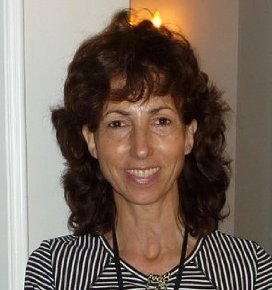
The Family Travel Forum - A
community for those who "Have Kids, Still Travel" and
want to make family vacations more fun, less work and
better value. FTF's travel and parenting features,
including reviews of tropical and ski resorts, reunion
destinations, attractions, holiday weekends, family
festivals, cruises, and all kinds of vacation ideas
should be the first port of call for family vacation
planners. http://www.familytravelforum.com/index.html
ALL YOU NEED BEFORE YOU GO


MARIANI'S VIRTUAL GOURMET
NEWSLETTER is published weekly. Editor/Publisher: John
Mariani.
Contributing Writers: Christopher Mariani, Robert Mariani,
John A. Curtas, Edward Brivio, Mort Hochstein,
Suzanne Wright, and Brian Freedman. Contributing
Photographers: Galina Stepanoff-Dargery,
Bobby Pirillo. Technical Advisor: Gerry McLoughlin.
© copyright John Mariani 2011
